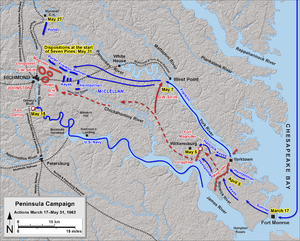
The Battle of Gettysburg was a three-day battle in the American Civil War fought between Union and Confederate forces between July 1 and July 3, 1863, in and around Gettysburg, Pennsylvania. The battle, which was won by the Union, was the Civil War's turning point, ending the Confederacy's aspirations to establish an independent nation, and the war's bloodiest battle, claiming some 50,000 combined casualties.

The Battle of Chancellorsville, April 30 – May 6, 1863, was a major battle of the American Civil War (1861–1865), and the principal engagement of the Chancellorsville campaign.

The Battle of Fredericksburg was fought December 11–15, 1862, in and around Fredericksburg, Virginia, in the Eastern Theater of the American Civil War. The combat, between the Union Army of the Potomac commanded by Maj. Gen. Ambrose Burnside and the Confederate Army of Northern Virginia under Gen. Robert E. Lee, included futile frontal attacks by the Union army on December 13 against entrenched Confederate defenders along the Sunken Wall on the heights behind the city. It is remembered as one of the most one-sided battles of the war, with Union casualties more than twice as heavy as those suffered by the Confederates. A visitor to the battlefield described the battle as a "butchery" to U.S. President Abraham Lincoln.

The Second Battle of Bull Run or Battle of Second Manassas was fought August 28–30, 1862, in Prince William County, Virginia, as part of the American Civil War. It was the culmination of the Northern Virginia Campaign waged by Confederate Gen. Robert E. Lee's Army of Northern Virginia against Union Maj. Gen. John Pope's Army of Virginia, and a battle of much larger scale and numbers than the First Battle of Bull Run fought on July 21, 1861, on the same ground.
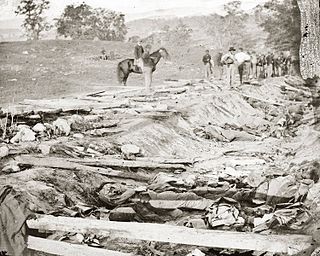
The Battle of Antietam, or Battle of Sharpsburg particularly in the Southern United States, was a battle of the American Civil War fought on September 17, 1862, between Confederate Gen. Robert E. Lee's Army of Northern Virginia and Union Gen. George B. McClellan's Army of the Potomac near Sharpsburg, Maryland, and Antietam Creek. Part of the Maryland Campaign, it was the first field army–level engagement in the Eastern Theater of the American Civil War to take place on Union soil. It remains the bloodiest day in American history, with a combined tally of 22,727 dead, wounded, or missing. Although the Union army suffered heavier casualties than the Confederates, the battle was a major turning point in the Union's favor.

The Battle of Yorktown or Siege of Yorktown was fought from April 5 to May 4, 1862, as part of the Peninsula Campaign of the American Civil War. Marching from Fort Monroe, Union Maj. Gen. George B. McClellan's Army of the Potomac encountered Maj. Gen. John B. Magruder's small Confederate force at Yorktown behind the Warwick Line. McClellan suspended his march up the Peninsula toward Richmond and settled in for siege operations.

The Peninsula campaign of the American Civil War was a major Union operation launched in southeastern Virginia from March to July 1862, the first large-scale offensive in the Eastern Theater. The operation, commanded by Major General George B. McClellan, was an amphibious turning movement against the Confederate States Army in Northern Virginia, intended to capture the Confederate capital of Richmond. McClellan was initially successful against the equally cautious General Joseph E. Johnston, but the emergence of the more aggressive General Robert E. Lee turned the subsequent Seven Days Battles into a humiliating Union defeat.
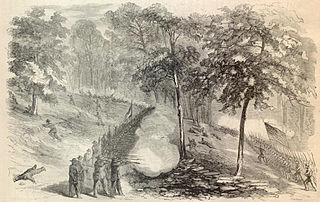
The Battle of South Mountain, known in several early Southern accounts as the Battle of Boonsboro Gap, was fought on September 14, 1862, as part of the Maryland campaign of the American Civil War. Three pitched battles were fought for possession of three South Mountain passes: Crampton's, Turner's, and Fox's Gaps.

The Seven Days Battles were a series of seven battles over seven days from June 25 to July 1, 1862, near Richmond, Virginia, during the American Civil War. Confederate General Robert E. Lee drove the invading Union Army of the Potomac, commanded by Maj. Gen. George B. McClellan, away from Richmond and into a retreat down the Virginia Peninsula. The series of battles is sometimes known erroneously as the Seven Days Campaign, but it was actually the culmination of the Peninsula Campaign, not a separate campaign in its own right.

The Battle of Eltham's Landing, also known as the Battle of Barhamsville, or West Point, took place on May 7, 1862, in New Kent County, Virginia, as part of the Peninsula Campaign of the American Civil War. Brig. Gen. William B. Franklin's Union division landed at Eltham's Landing and was attacked by two brigades of Brig. Gen. G. W. Smith's command, reacting to the threat to the Confederate army's trains on the Barhamsville Road. Franklin's movement occurred while the Confederate army was withdrawing from the Williamsburg line, but he was unable to interfere with the Confederate movement.

The Battle of Seven Pines, also known as the Battle of Fair Oaks or Fair Oaks Station, took place on May 31 and June 1, 1862, in Henrico County, Virginia, nearby Sandston, as part of the Peninsula Campaign of the American Civil War. It was the culmination of an offensive up the Virginia Peninsula by Union Maj. Gen. George B. McClellan, in which the Army of the Potomac reached the outskirts of Richmond.
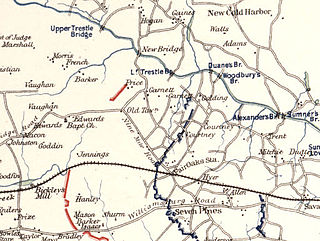
The Battle of Oak Grove, also known as the Battle of French's Field or King's School House, took place on June 25, 1862, in Henrico County, Virginia, the first of the Seven Days Battles of the American Civil War. Maj. Gen. George B. McClellan advanced his lines with the objective of bringing Richmond within range of his siege guns. Two Union divisions of the III Corps attacked across the headwaters of White Oak Swamp, but were repulsed by Maj. Gen. Benjamin Huger's Confederate division. McClellan, who was 3 miles (4.8 km) in the rear, initially telegraphed to call off the attack, but ordered another attack over the same ground when he arrived at the front. Darkness halted the fighting. Union troops gained only 600 yards (550 m), at a cost of over a thousand casualties on both sides.

The Battle of Beaver Dam Creek, also known as the Battle of Mechanicsville or Ellerson's Mill, took place on June 26, 1862, in Hanover County, Virginia. It was the first major engagement of the Seven Days Battles during the Peninsula Campaign of the American Civil War. It was the start of Confederate General Robert E. Lee's counter-offensive against the Union Army of the Potomac, under Maj. Gen. George B. McClellan, which threatened the Confederate capital of Richmond. Lee attempted to turn the Union right flank, north of the Chickahominy River, with troops under Maj. Gen. Thomas J. "Stonewall" Jackson, but Jackson failed to arrive on time. Instead, Maj. Gen. A.P. Hill threw his division, reinforced by one of Maj. Gen. D.H. Hill's brigades, into a series of futile assaults against Brig. Gen. Fitz John Porter's V Corps, which occupied defensive works behind Beaver Dam Creek. Confederate attacks were driven back with heavy casualties. Porter withdrew his corps safely to Gaines Mill, with the exception of Company F of the 8th Pennsylvania Reserve Regiment who did not receive the orders to retreat.

The Battle of Gaines' Mill, sometimes known as the Battle of Chickahominy River, took place on June 27, 1862, in Hanover County, Virginia, as the third of the Seven Days Battles which together decided the outcome of the Union's Peninsula Campaign of the American Civil War. Following the inconclusive Battle of Beaver Dam Creek (Mechanicsville) the previous day, Confederate General Robert E. Lee renewed his attacks against the right flank of the Union Army, relatively isolated on the northern side of the Chickahominy River. There, Brig. Gen. Fitz John Porter's V Corps had established a strong defensive line behind Boatswain's Swamp. Lee's force was destined to launch the largest Confederate attack of the war, about 57,000 men in six divisions. Porter's reinforced V Corps held fast for the afternoon as the Confederates attacked in a disjointed manner, first with the division of Maj. Gen. A.P. Hill, then Maj. Gen. Richard S. Ewell, suffering heavy casualties. The arrival of Maj. Gen. Stonewall Jackson's command was delayed, preventing the full concentration of Confederate force before Porter received some reinforcements from the VI Corps.

The Battle of Savage's Station took place on June 29, 1862, in Henrico County, Virginia, as the fourth of the Seven Days Battles of the American Civil War. The main body of the Union Army of the Potomac began a general withdrawal toward the James River. Confederate Brig. Gen. John B. Magruder pursued along the railroad and the Williamsburg Road and struck Maj. Gen. Edwin Vose Sumner's II Corps with three brigades near Savage's Station, while Maj. Gen. Thomas J. "Stonewall" Jackson's divisions were stalled north of the Chickahominy River. Union forces continued to withdraw across White Oak Swamp, abandoning supplies and more than 2,500 wounded soldiers in a field hospital.
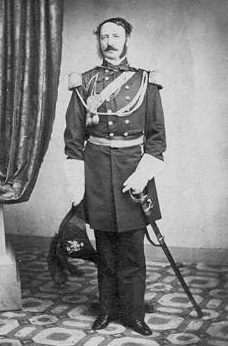
John Bankhead Magruder was an American and Confederate military officer. A graduate of West Point, Magruder served with distinction during the Mexican–American War (1846–1848) and was a prominent Confederate Army general during the American Civil War (1861–1865). As a major general, he received recognition for delaying the advance of Maj. Gen. George B. McClellan's large force, the Army of the Potomac, during the 1862 Peninsula Campaign, as well as recapturing Galveston, Texas the following year.
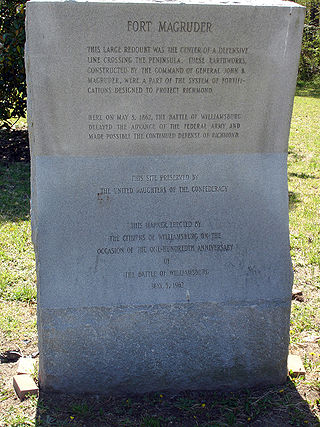
Fort Magruder was a 30-foot (9.1 m) high earthen fortification straddling the road between Yorktown and Williamsburg, Virginia, just outside the latter city during the American Civil War. At the center of the Williamsburg Line, it was also referred to as Redoubt Number 6.

The eastern theater of the American Civil War consisted of the major military and naval operations in the states of Virginia, West Virginia, Maryland, and Pennsylvania, the District of Columbia, and the coastal fortifications and seaports of North Carolina.
The following Confederate Army units and commanders were the initial structure on April 30, 1862 of the Confederate Army of Northern Virginia during the Peninsula campaign of the American Civil War. It contains units throughout Virginia that influenced the campaign. The Union order of battle is listed separately.

The Battle of Malvern Hill, also known as the Battle of Poindexter's Farm, was fought on July 1, 1862, between the Confederate Army of Northern Virginia, led by Gen. Robert E. Lee, and the Union Army of the Potomac under Maj. Gen. George B. McClellan. It was the final battle of the Seven Days Battles during the American Civil War, taking place on a 130-foot (40 m) elevation of land known as Malvern Hill, near the Confederate capital of Richmond, Virginia and just one mile (1.6 km) from the James River. Including inactive reserves, more than fifty thousand soldiers from each side took part, using more than two hundred pieces of artillery and three warships.

